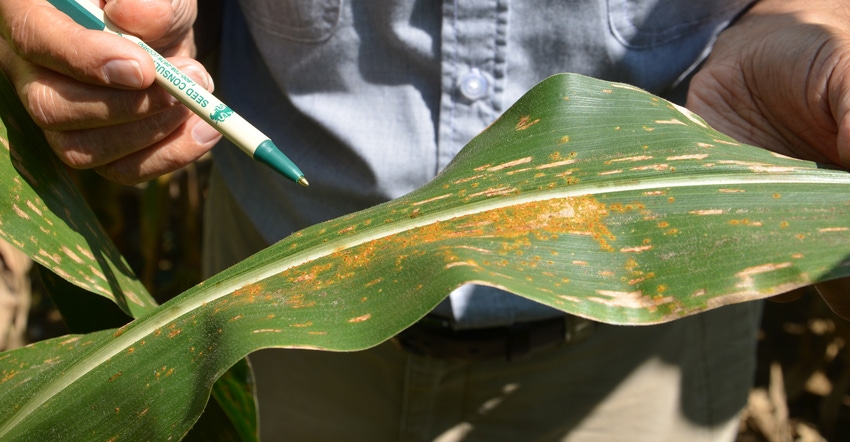May 31, 2018

My dad and I agreed we wouldn’t apply fungicide on corn to save money. All our hybrids were rated good or excellent on diseases, except southern rust. We live in central Indiana. Dad is getting cold feet and wants to spray. I disagree. Can you give us any guidelines?
The panel of Indiana certified crop advisers answering this question includes Don Burgess, agronomist with A&L Great Lakes Labs, Fort Wayne; Jesse Grogan, agronomist with Ag Reliant Genetics, Lafayette; and Bryan Overstreet, Purdue University Extension ag educator in Jasper County.
Burgess: It’s very unlikely that a fungicide application is needed here. Plant diseases require three factors to establish: the disease-causing organism, a susceptible host and favorable environmental factors. These three factors, often referred to as the disease triangle, all must be present for any plant disease to develop. Since a hybrid with strong disease resistance was selected, the susceptibility of the host has been greatly reduced. Genetic disease resistance is a good tool that will greatly lessen the likelihood of infection.
Southern rust, like common rust, doesn’t generally overwinter in Indiana due to the lack of a viable host. It must be blown in from the South to infest Indiana crops. In addition, southern rust is generally favored by warm, moist conditions. If the weather is hot with high humidity and heavy dews, these conditions may favor southern rust if the organism is present in your area. The best advice is to scout your fields and look for any symptoms of diseases or other problems.
Grogan: There are guidelines to spray for southern rust. Southern rust overwinters in Mexico and along the Gulf Coast on early-planted corn. It moves on summer winds and drops into the corn crop during storms. The rate of spread for southern rust depends on how early it starts and moves up the Mississippi River Valley. Disease development is rapid once it arrives. Heavy losses are experienced with two weeks of heavy infestation on susceptible hybrids. Hot and humid weather is ideal for development and local spread.
Southern rust usually arrives late in the season for central Indiana, from about the dent to black layer stage, and corn escapes the disease threat. However, corn planted south of Interstate 70, especially along the Ohio River, has experienced significant losses in recent years. Southern rust caused heavy losses in southern Indiana in 2016 due to hot and humid weather. It showed up again in 2017, but conditions were cool and drier, and the disease didn’t develop as expected.
If southern rust is identified at the flowering stage or two weeks after in your fields and counties near you, and there is an extended period of hot and humid weather expected, a preventative application could be applied.
Overstreet: Generally, rust spores blow in too late to do significant damage. You can watch reports from Kentucky to see if rust is moving your way. Southern rust requires dew periods of at least seven hours to survive and temperatures in the upper 70s and lower 80s. Spores usually arrive in late July and early August. If you decide to spray, there are several fungicides that are effective. Make sure you look at harvest restrictions.
Look at the Purdue Extension publication “Fungicide Efficacy for Control of Corn Diseases,” BP-160-W, to help you decide what fungicide to use. For more information, check out “Common and Southern Rusts,” BP-82-W. You can find these publications at edustore.purdue.edu.
You May Also Like




